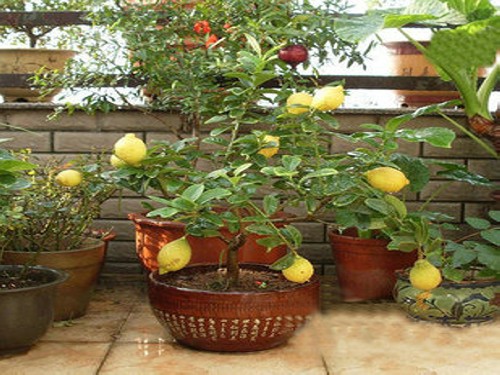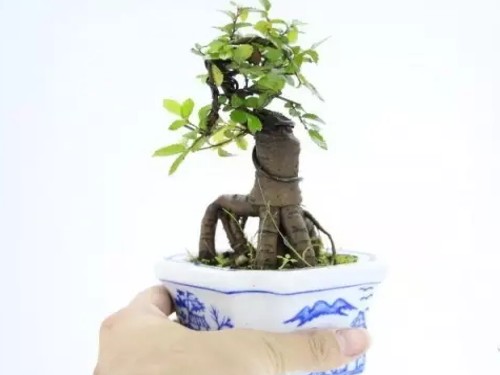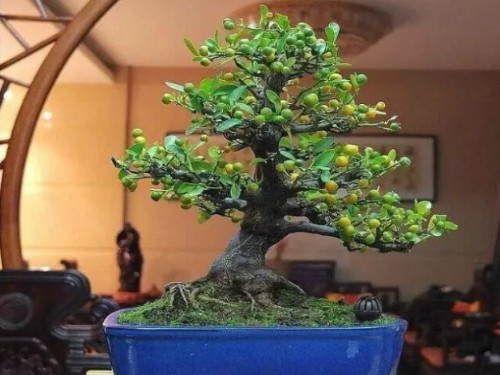How to cultivate potted lemons-cultivation methods of potted lemon trees
Planting some plants at home not only beautifies the environment, but also brings people a very pleasant mood. Watering flowers and plants every day is a kind of enjoyment. Recently, there are more and more potted plants at home, approaching 20 pots, and the long row on the balcony is a beautiful landscape. Usually many fruit seeds can be used to make potted plants. Here are the specific ways to share the conservation and management of lemon potted plants. People who love life also have a try.
Family potted lemon tree is easy to maintain, lemon tree is a small tree, pruning is very critical, to limit its height, but also to prevent the loss of water, fertilizer and nutrition. Potted lemon trees, such as improper management, often only blossom, no fruit or little fruit, or even do not blossom. In order to make potted lemon blossom and bear fruit year after year, scientific management must be carried out in water, fertilizer, pruning and other links in order to achieve the goal of abundant fruit. The following is to share the culture methods of lemon trees.

How to maintain and manage lemon trees? The main steps are as follows:
1. "buckle water" before flowering
In order to prevent excessive growth of summer shoots, accumulate nutrients and promote the formation of buds, potted lemon trees were "watered" before the End of Heat. The specific approach is that the water supply to potted lemon trees gradually decreased in the first ten days of the End of Heat; the water supply was stopped in the first five days, and the water in the basin soil evaporated greatly, and the basin soil dried up; the root system lost water in branches and leaves, and the leaves were withered and curled due to lack of water. In order to prevent leaf dehydration, water can be sprayed to the leaf surface in the morning and evening, and a small amount of water can also be sprayed to the basin soil, so that the lemon tree is under the condition of drought and not dying, its axillary buds are expanding day by day, and the bud color changes from green to white. when most of the axillary buds turn from green to white, the "buckle water" to promote flowers is successful. At this time, it is necessary to restore the water supply to the potted lemon trees in time.
2. Protect flowers and fruits
After the lemon tree blossoms, in addition to applying thin fertilizer once a week, it is also necessary to thinning flowers and fruits. First remove part of the buds before the flowers bloom; after the flowers are shedding and setting fruit, then remove some misplaced young fruits, in order to reduce the consumption of nutrients, let the limited nutrients concentrate on supplying the retained flowers and fruits, and make the fruits grow bigger and better. During the period of fruit growth, if the fertilizer and water are sufficient and the plant nutrition is good, some branches will sprout new shoots, and the growth of new shoots will inevitably divert some nutrients and affect the growth of the fruit. In order to preserve the fruit, the new shoots should be erased in time. When the fruit is yellow and ripe, stop fertilizing and reduce watering to keep the soil moist and slightly dry. If you continue to give too much fertilizer and water, the fruit will mature and fall early and shorten the viewing time.
3. Rational fertilization
Lemon trees like fertilizer, so they should apply more thin fertilizer at ordinary times. The plants were treated with rotten liquid fertilizer before sprouting, and then every 7-10 days with liquid fertilizer dominated by nitrogen fertilizer to promote the growth of branches and leaves and multiple spring shoots. After picking the heart every time, it is necessary to apply fertilizer in time to make the branches mature earlier. During the growth of the lemon tree, you can sprinkle some cake fertilizer on the basin, so that some fertilizer seeps into the soil every time it is watered to enhance its fertility. After entering autumn, fertilization is reduced to avoid overnutrition of plants, promote autumn shoots, and compete with fruits for nutrients, resulting in fruit drop.
4. Reasonable pruning
There are two reasons for pruning of potted lemon trees: one is that the pots are small, the soil is few, and the nutrients provided are limited, which can not meet the growth needs of lemon trees and must be pruned; the other is to adjust the rational distribution of nutrients in the tree by shaping and pruning, so that limited nutrients are concentrated to supply buds and leaves to form more fruiting branches, so as to achieve full branches of flowers and fruits. Before spring shoot germination, potted lemon trees must be pruned intensively, such as withered branches, diseased branches, overgrown branches, introverted branches, cross branches, sprouting branches and so on. Leave 4.5 full buds for strong branches and 2.3 buds for weak branches to promote more robust spring shoots on each branch. After the spring shoot has grown, in order to control its overgrowth, light cutting can be carried out to cut off 3.4 nodes of the branch tip. The new shoots will be plucked when there are 6-8 knots, in order to induce more summer shoots.
5. Turn the basin
Due to the lack of potted soil and limited nutrient supply, the potted lemon tree lacks soil fertility after many years, and the lemon tree will weaken year by year, blossom less and bear less fruit. In order to keep the lemon tree blooming and bearing fruit year after year, the pot must be turned. The best time to turn the pot is half a month before the lemon tree sprouts. Before turning the basin, first prepare a basin larger than the original basin, remove the lemon from the basin, do not break the mud mass, cut off the 1.2 cm thick surface soil along the mud mass, cut off the withered root and rotten root, and cut off the soil 1 cm thick at the bottom of the mud mass, take out the tiles trapped in the original basin bottom mat. The drainage hole of the new basin is laid with tiles, first with a drainage layer of 2.3 cm thick, and then with a layer of nutrient-rich culture soil 4.5 cm thick, mixed with a small amount of calcium superphosphate. Then put the lemon tree mud into the basin, fill the culture soil around to the basin mouth, slightly compact the basin soil, pour enough fixed root water, put it in a ventilated and semi-shaded place, and put it back to the same place a week later for daily management.
Key points of daily maintenance management:
1. Artificial pollination: artificial pollination is an important measure for multi-hanging fruit, and pollination should be carried out in time after the petals grow. This work should be carried out around 9 o'clock every morning, and the effect is better.
2. Noon shading: when the temperature exceeds 30 ℃ at noon, the lemon tree should be shaded for about 3 hours after flowering to before hanging fruit, otherwise it will affect the normal shape of flowers and prevent the plant from hanging fruit.
3. Prevent defoliation: fallen leaves affect the fruit of lemon trees. In order to avoid falling leaves, watering is avoided in daily management.
4. Rational fertilization: before flowering and after hanging fruit, lemon trees should be fertilized many times, apply multi-element flower fertilizer once a month, and spray flower nutrient solution once a month to ensure that the fruit is not easy to fall off.
5. Spring pruning: spring pruning in combination with changing pots in spring, cutting off inner bore branches, withered branches and leaves, roots and leaves of diseases and insect pests, and growing branches, so as to facilitate the plant to hang fruit.
6. change the pot and change the soil: the potted lemon tree must turn the pot and change the soil from March to April in spring. If the flowerpot is too small, you can change the adaptive flowerpot, if the flowerpot is still suitable, the original pot can be replaced with new soil, and the bottom fertilizer should be applied when changing the pot.
7. Prevention and control of diseases and insect pests: summer and autumn is the season of frequent occurrence of diseases and insect pests in lemon trees. Prevention and control of diseases and insect pests should be more important than control, spraying once every semimonthly, spraying time is about 9: 00 in the morning, about 4: 00 in the afternoon, the hot sun should not be sprayed at noon to prevent drug damage.
In combination with my reality, I would like to share with you the cultivation methods of family potted lemons:
1. Lemons usually bear fruit in two years, but they can bear more in three years. First of all, you have to do this. We are all potted plants. We must change the soil in spring and autumn. I am a big foam box. Pull out the whole lemon, shovel off all the fine roots except the main root, then cover the bottom of the pot with fertilizer soil, a layer of pastoral soil, and then plant it. This is very simple, if the seedling is not big, it is not physical work.
2. After planting, let it grow after autumn, and let it grow. Winter is almost over, about before and after the Beginning of Spring. At this time, you should pay attention. This is the time to let lemons blossom and bear fruit: you put some branches, slender and sturdy, it doesn't matter. As far as possible, be sure to bend downward as far as possible, forming an n-shape with the branches at the bottom, be careful not to break it when bending, all right, fix it with a rope, and try to make more n-shapes of the whole lemon, which will promote nutrients to go down, bloom more and bear more fruit.
3. The rest is simple. As long as you pay attention to pollination when you bloom and fertilize the fruit, you will have no problem with keeping flowers and fruits.
4. Some flower friends mentioned that some lemons have long leaves and do not blossom. This is also a common problem with lemons. Here please pay attention to the flower friends, lemon is to be pruned! We are unlikely to prune as often as fruit growers.
5, lemon leaves, if it is perfume lemon, cut off the leaves do not throw away, oh, used to steam fish. When the fish is ready, bring a smell of lemon! When there are too many leaves, they are wrapped in gauze, or packed in any box, and put in the room is a natural spice.
6. Besides, here comes the secret decision. In the summer, time must be mastered, around the end of August or the beginning of September, gradually. Don't water the lemon slowly. I am very hot here, I usually give it a small glass of water every day, wait for the soil in the basin to dry, you can see that the lemon leaves have become very dry, almost GAME OVER, at this time once again to water thoroughly, return to normal water supply. Be sure to keep it under control and don't be hung up by the drought. I'm usually pretty good at this process.
Time: 2019-05-31 Click:
- Prev

How to maintain the bonsai of hammer elm
The dried elm is slightly curved, the bark is mottled and elegant, the twigs are graceful, and the autumn leaves turn red. It is a good ornamental tree and factory greening, greening tree species on all sides, often planted alone into a scene, suitable for planting near the pond and pavilions, but also between mountains and rocks, but there are more diseases and insect pests. It has strong sprouting power and is a good material for making bonsai. The tree is graceful
- Next

Conservation method of bonsai of orange in Jindou Mountain
Jindou mountain tangerine is a kind of tree. It is not only a wild plant, but also can be cultivated artificially. It is a characteristic plant with many effects and functions. The fruits and leaves of this plant can be used as medicine to treat a variety of human diseases. In recent years, mountain tangerine has become the most popular tree species in Lingnan, not to mention its advantages.
Related
- Fuxing push coffee new agricultural production and marketing class: lack of small-scale processing plants
- Jujube rice field leisure farm deep ploughing Yilan for five years to create a space for organic food and play
- Nongyu Farm-A trial of organic papaya for brave women with advanced technology
- Four points for attention in the prevention and control of diseases and insect pests of edible fungi
- How to add nutrient solution to Edible Fungi
- Is there any good way to control edible fungus mites?
- Open Inoculation Technology of Edible Fungi
- Is there any clever way to use fertilizer for edible fungus in winter?
- What agents are used to kill the pathogens of edible fungi in the mushroom shed?
- Rapid drying of Edible Fungi

